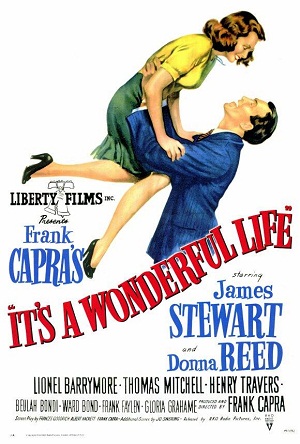
Director – Frank Capra
Writer(s) – Frances Goodrich, Albert Hackett, Frank Capra
Stars – James Stewart, Donna Reed, Lionel Barrymore
Shockingly enough, when first released, It’s A Wonderful Life was both a critical and commercial flop. Over time however, it would go on to gain a huge legacy as an all-time classic of the ‘Golden Age’ and would be eternally remembered as a magical family Christmas affair. For these reasons, I always had a pre-existing stigma about the film; forever fearing it would be a cheesy and contrived generic family fodder. I could not have been more wrong, as this is actually a relatively dark and somber affair, as we see George Bailey (the immortal James Stewart) continually sacrifice his own happiness and well-being in his neverending quest to better the lives of those around him.
This leads to a life-long duel with the tyrannical corporate bad guy Henry F.Potter (Lionel Barrymore), who desires to monopolise the entire town in which they both live. George refuses to budge, and over time, we see him pushed closer and closer to the edge of his tether, before finally he stands at the top of a bridge, Christmas Eve, considering the end of it all. It is then that the angel that has been watching his entire life (serving as a very meta link between the audience and the movie) who steps in to intervene, save George’s soul, and in turn earn his own wings. It is a remarkably unique synopsis, and in particular, the use of the angels is a very ‘meta’ piece of cinema, back in an age when cinematic self-awareness was a rarity. This is a film that knows it is a film and has absolutely no issues letting the audience in on this, and thus it instantaneously stands out among its historical peers as one of the ‘Golden-Age’s’ most intelligent works.
One thing I noted whilst reviewing 12 Angry Men (Sidney Lumet, 1957) was that this era of cinema was defined by their beautiful screenplays. In the days before the blockbuster era led to simplified and dumbed-down scripts stocked full of exposition and tripe, this is a beautifully written piece of work. The writing falls in that beautiful little spot between authentic realism and cinematic writing. Whilst you watch James Stewart’s George wooing Donna Reed’s Mary, it makes even the most stony heart warm, as its the type of courting and love that we all dream of, even if we’d never admit it. ‘You want the moon, Mary? Just say so, and I’ll put a lasso over it and bring it ya. I’ll give you the moon Mary, how about that?’. It’s the kind of quote that everybody, male or female, in their most private moments, would love to hear at least once in their lifetimes. Thus it resonates, deeply within us all. That, my friend, is intelligent and beautiful writing.
In terms of cinematography, the film is very solid, particularly in terms of the era, and the use of shot choices is very standard golden-age, not particularly innovative or new, but simultaneously everything works and looks quite beautiful. However, there were two things that really bugged me; firstly, the use of jump cuts, seemingly at random intervals, felt less like a stylistic choice, and more like poor editing. In fact, one could reasonably assume that they simply lost some reels of film somewhere. It’s awfully jarring, as a character can be in the midst of a conversation one moment, then several inches to their left one shot later. In a Von Trier art-piece, it would make sense as a stylistic choice. However, against this backdrop of Golden-Age style filmmaking, it does appear more an error than a choice. Also, that bloody wash-fade effect. Perhaps at the time of making it was new and innovative, but after one has seen it for seemingly the twentieth time within two hours, it loses a little of its punch.
Those gripes aside, the story is a brilliant one, and fantastically told, especially in terms of performances. Jimmy Stewart’s legacy as an icon is more than well earned. He is absolutely electric throughout, and the man appears as if he literally urinates charisma. He’s charming, witty, well-spoken and that drawl of his is endearing, as opposed to annoying. Also, Lionel Barrymore’s evil Mr.Potter is a deliciously manipulative and slimy bastard, and one of cinema’s first ‘Maniacal corporate asshole’ villains and possibly my favourite. The rest of the performances are solid, if unspectacular, but the central relationship and juxtaposition between Stewart and Potter’s performances drive the film and provide (almost) all of the best moments. Of course, the ‘Moon scene’ would never have worked without the dynamite chemistry between Stewart and Donna Reed, as every single moment between the two is emotional, heart-warming and, most importantly, believable.
It is a sad and damning comment on the stagnation of the development of human kindness and decency that a film, made seventy years ago, has a central message that is just as relevant now as it was then, and I imagine, sadly, will be just as relevant in another seventy years. The film’s central messages and themes are simple, but needed; be a better human being, don’t throw other humans away in the pursuit of wealth and greed, people are not disposable, and nobody without friends can ever claim to have truly wasted their life. This is a moving, powerful and relevant film, even today, that possesses that rare ability to move every human being, from the open-minded and warm-hearted, to the most cynical and icy-hearted of men. It’s A Wonderful life, is, truly and utterly, a wonderful movie.
Final Rating – 4.3